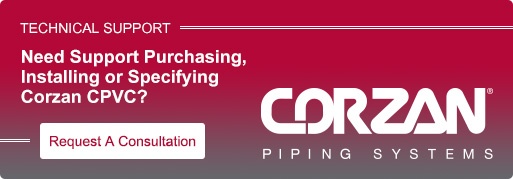Installed Costs Overview: CPVC vs. PP-R for Commercial Plumbing
Should the extra cost of expansion loops drive your decision making about which plastic pipe to use for your next commercial plumbing project? If you are thinking of using polypropylene piping instead of CPVC for that reason, read on.
The material known as PP-R (polypropylene random copolymer) is available commercially in a reinforced and non-reinforced form. The fiber-reinforced composite product typically used for hot water lines is effective at reducing longitudinal thermal expansion and contraction, with the promise of eliminating the need to accommodate for expansion and contraction. A common belief is that a PP-R project in turn should have competitive installed costs because the need for expansion loops has been reduced or eliminated.
In reality, installed costs for Corzan CPVC are consistently lower, not higher, for a host of reasons. While changes in direction, offsets or loops are part of good design and installation, the amount of labor required is insignificant when compared to the additional costs and considerations for a PP-R system, such as:
- The material cost alone for PP-R ranges from 25% to 200% higher than Corzan CPVC, depending on whether the reinforced or non-reinforced PP-R is chosen.
- The recommended joining method for CPVC is solvent welding; a quick and highly reliable process for the well-trained installer. Requiring only inexpensive handheld tools, the process produces a molecularly bonded joint that is the strongest part of the piping system. In contrast, PP-R installation is a heat fusion process involving expensive tools and if not done properly, can lead to bead formation around the inside of the pipe which reduces the designed water flow rate.
- Corzan CPVC installations are not labor-intensive. One installer can do the work singlehandedly, and three times faster with no electricity required to preheat and power the fusion tool. There is no need to limit the number of joints being prepared at one time either, because daubers are not expensive.
- Safety and ergonomic concerns are favorable with CPVC. Solvent cementing is easy in tight, confined spaces as well as overhead installs. In contrast, the weight of a fusion machine makes overhead joints of PP-R more taxing ergonomically and requires a second installer.
- The CPVC workspace is more manageable because there is no concern of fire or burn risk. With PP-R, the perimeter of the space must be cordoned off and properly signed so that unauthorized people keep their distance and avoid interactions with irons or fusion tools that could lead to burns.
- For possible mixed-metal integrations, adding Corzan CPVC into an existing copper water supply system is no more complicated than a standard installation because there are no incompatibility issues. With PP-R, the owner, engineer or contractor is responsible for costly and time-consuming water testing prior to installation to verify that PP-R’s operating parameters won’t lead to water issues from copper corrosion and contact with copper ions.
- Finally, jobsite cleanup with CPVC requires a simple solvent cleaner. With PP-R an applicator must take time to remove molten material from fusion tools.
Looking at just one element in isolation of the installed costs picture can lead to a lopsided assessment of total installed costs. Corzan Piping Systems are backed by 60 years of successful installations, with time-tested advantages in plumbing and hydronics that contractors know and appreciate.


